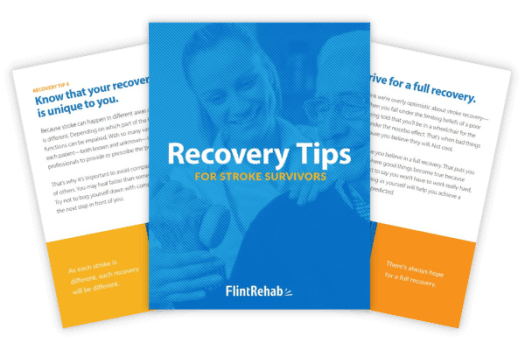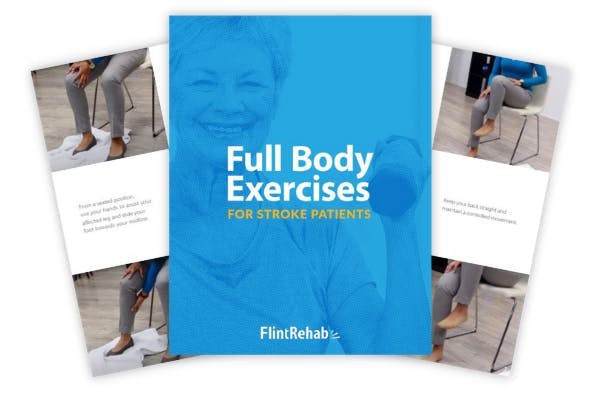No products in the cart.
No products in the cart.
No products in the cart.
No products in the cart.
Home » Neurological Recovery Blog » Stroke » How to Recover from Stroke Quickly: 11 Ways to Boost Recovery
Last updated on January 24, 2024

On the road to recovery, it can be tempting to look for methods to recover from stroke quickly. Fortunately, while stroke recovery is a lengthy process, there are several ways to maximize your rehab potential! Nevertheless, it’s also important to acknowledge that there are no quick fixes for healing the brain. This is why an intentional, consistent rehab plan is so important for stroke recovery.
Every stroke is different and every recovery is different as a result. This means all survivors recover from stroke at different rates, with some seeing recovery more quickly than others. Everyone’s unique stroke recovery timeline is based on their specific injury and other personal factors. Luckily, there are ways to help you improve the effectiveness and efficiency of your recovery.
Did you know that the brain can bounce back from injury and heal itself after a stroke? This process is called neuroplasticity. Neuroplasticity allows the brain to reorganize and rewire itself as efficiently as possible. After a stroke has caused injury to different areas of the brain, neuroplasticity encourages healthy areas of the brain to pick up the slack.
However, to encourage recovery, the brain needs constant stimulation. When you repeat a thought or task regularly, the brain attempts to become more efficient at that thought or task. This is why high repetition or massed practice of therapeutic exercise is so important for recovering from stroke as quickly as possible.
Stimulate neuroplasticity by focusing on activities that stimulate and rewire your brain. Your therapy team will help you create a rehab plan that can help you achieve this. Then, it takes consistency to reap the benefits. In this post, we will review 11 helpful ways you can take charge of your stroke recovery journey.
Before we dive in, however, we’d like to add a note on “snake oil salesmen.” Be very careful if someone promises you fast results during stroke recovery. Some remedies promise fast results but there is poor clinical evidence behind them. The brain heals itself through incremental changes. If you’re putting in the work consistently, you can maximize your chances of recovery — and recover from stroke as quickly as possible.
Now that you understand the basics of how stroke recovery works, let’s dig into the different ways you can speed up the process. This list isn’t exhaustive, and every survivor will need to find a routine that best meets their individual needs. By learning more about recovery and using these rehab strategies, you can maximize your outcome and improve your independence. Let’s get started!
Quick tip: Stimulation and repetitive practice are essential for recovery.
Repetition is a critical ingredient during recovery from stroke. Repetition activates neuroplasticity, which is your brain’s mechanism for rewiring itself and creating efficiency. This is how you can rebuild your skills and overcome the secondary effects of a stroke.
During inpatient therapy, you will spend many hours each day practicing various exercises to rebuild lost skills. This helps activate neuroplasticity and improves your ability to perform daily activities. For instance, practicing leg exercises can improve your ability to walk after a stroke.
Even after you are discharged from inpatient or outpatient therapy, it is crucial to continue your home exercise program. Practicing these skills daily will promote a faster recovery and provide the stimulation your brain needs to relearn lost skills.
Quick tip: Improving your gait (ability to walk) is a full-body task.
If you struggle with walking after stroke, your physical therapist can help you recover by showing you which exercises to practice. In addition to leg exercises, your therapist will likely recommend different exercises for your feet, core, and balance. Be sure to practice exercises for the full body as walking is a full-body task.
If you struggle with consistency, consider using a home exercise program like FitMi home therapy. It tracks your progress and encourages high repetition of full-body exercises to help you reach your goals. The more you practice, the more you can increase your confidence and safety while improving your mobility.
Want 25 pages of stroke recovery exercises in a PDF? Click here to download our free Stroke Rehab Exercise ebook now (link opens a pop up for uninterrupted reading)
Quick tip: AFOs are important for safety, but don’t forget to exercise too.
AFOs (ankle foot orthotics) for foot drop can help improve your gait substantially and are a valuable tool for stroke survivors. This is especially true for survivors who are affected by hemiplegia or hemiparesis, referring to paralysis or weakness of one side of the body.
If you have difficulty lifting your foot (also known as dorsiflexion), walking can be incredibly challenging and unsafe. For this reason, AFOs can be crucial for preventing falls as you move about your daily life. If you struggle with foot drop, be sure to ask your therapist for help.
While these devices are incredibly helpful, it’s important to know that AFOs are a compensation technique. This means that they help you adapt to disability but do not necessarily promote recovery. This does not mean you should skip wearing your AFO. Instead, be sure to practice your foot drop exercises daily to enhance your recovery. In doing so, you are reducing the risk of learned non-use and can recover from stroke-related foot drop more quickly.
Quick tip: Speech therapy apps are a great way to improve speech at home.
If you had a left-brain stroke, you may have language difficulties like aphasia. A speech therapist (called a speech-language pathologist) can diagnose your specific type of aphasia and guide you through recovery. They can also help address difficulty swallowing, or dysphagia.
However, attending speech therapy once per week does not necessarily provide enough stimulation for the brain to induce neuroplasticity. If you want to recover from stroke quickly, you need to stay engaged in therapy at home, too. This is where speech therapy apps can help.
Apps are available straight from your phone or tablet any time you need them. You don’t need to wait to see your therapist to keep your brain engaged in therapy. Best of all, you can ask your therapist to assign exercises that suit your needs.
Want 20 pages of stroke recovery tips in an illustrated PDF? Download our free ebook by clicking here (link opens a pop up for uninterrupted reading)
Quick tip: The stroke recovery plateau is a well-documented phenomenon, but it does not mean that recovery is over!
The first 3 to 6 months after stroke is generally the period when survivors experience the fastest improvements. This is largely due to a phenomenon known as spontaneous recovery, when neuroplasticity is most active. In many cases, stroke recovery tends to slow down after the 3-month mark. This “plateau” often causes patients to be discharged from inpatient therapy.
While a plateau in progress can be frustrating, this does not mean recovery has stopped altogether. In fact, it’s a sign to remain consistent with your home exercise program to keep recovery going. Without inpatient rehab to keep you engaged, it becomes more important to stick with a daily rehab regimen at home to recover from stroke as quickly as possible.
It is well-documented that recovery from stroke can continue far beyond the 3-month mark and into the chronic stage of recovery. In fact, there is evidence of stroke recovery as many as 23 years after the initial injury. There is always improvement to be made, so continue pursuing rehabilitation and working hard toward increasing your function.
Quick tip: It’s common to take two steps forward and one step back.
It is common to experience a regression in recovery, which can feel disheartening for survivors. However, this does not mean recovery is over. You should always talk with your doctor or therapist as a regression can indicate other complications.
If you feel like you took two steps forward and one step back, it can help to look at your progress during the previous week. Did you exert yourself more than usual? Did you make any changes to your routine or medications? If so, these changes may need to be examined more closely or you may need to change your routine slightly.
Again, be sure to check in with your doctor or therapy team. They can help you pinpoint what may be causing this regression and help you get back on track. You may find that a small regression (one step back) is followed by another phase of recovery (two steps forward).
Quick tip: Meditation is an underrated practice that can help accelerate recovery from stroke.
Do you know about the power of meditation for stroke recovery? At first glance, it might seem too simple to help. However, some clinical studies suggest meditation provides great benefits for stroke survivors. This can be especially helpful for those affected by post-stroke depression or anxiety.
Meditation can be an uncomfortable experience if you are accustomed to a busy schedule. However, don’t let uncertainty keep you from reaping the benefits of this brain-nourishing practice.
Quick tip: You can boost neurogenesis with specific healthy foods.
Neurogenesis is the creation of new neurons in the brain — something that could boost your efforts of recovering from stroke as quickly as possible. Some of the best foods for stroke recovery are ones that promote neurogenesis. Examples of these foods include fish, pomegranate, nuts, seeds, and blueberries.
This is just the tip of the iceberg, so spend time learning more about foods that boost neurogenesis. If you struggle with diet-related stroke risk factors, such as high cholesterol or obesity, talk to your doctor before making any new dietary changes. They may also be able to refer you to a dietician who can help you create a better dietary plan.
Quick tip: It’s common to sleep more than usual after a stroke as the brain is recovering.
Many stroke survivors can be startled or surprised by how much sleep they crave during recovery. If you find yourself sleeping excessively after stroke, know that this is not uncommon.
Sleep helps improve movement recovery after stroke by turning the short-term memories from the day into long-term memories. It also gives the brain time to rest and recharge. Getting high-quality sleep can be challenging for many stroke survivors but is a necessary piece of recovery.
If you are worried about how much you are sleeping or if insomnia is preventing you from getting enough sleep, talk to your doctor. Additionally, try practicing good sleep habits to prioritize the quality and quantity of your sleep.
Quick tip: Consistency is key if you want to recover from stroke quickly.
As we mentioned previously, neuroplasticity is the key to recovering as quickly as possible after stroke. In order to heal and rewire itself, your brain requires consistent stimulation and practice of challenging activities.
For this reason, inconsistent participation in rehab will slow your results due to lack of repetition. To recover as quickly as possible, you need to participate in therapy consistently.
If you struggle with staying motivated at home, try investing in a home exercise program that’s more interactive, such as Flint Rehab’s FitMi home therapy. It helps you accomplish the repetition necessary for recovery by turning rehab exercise into an interactive experience. Additionally, try out some fun apps for stroke patients to help make rehab more engaging!
Quick tip: Make big and small goals, then keep taking steps toward recovery.
Not all stroke survivors can achieve a full recovery. However, this does not mean that improvement is impossible. Many stroke survivors are told limiting beliefs about recovery, and yet they go on to achieve remarkable results.
What would happen if those individuals stopped rehab once they reached the limit imposed on them? They likely wouldn’t recover because they stopped rehab. For this reason, the team at Flint Rehab believes that everyone should strive for a full recovery from stroke.
Believing that a full recovery is possible will motivate you to take more action, which will naturally lead to better results. Even if you don’t get there 100%, you’ll get much farther by believing recovery is achievable. Start by creating meaningful goals, large and small, for your stroke recovery. As you continue to meet small goals, you may find that you are also getting closer to reaching the big goals you’ve created.
If you need help staying motivated, try reading successful stroke recovery stories from other survivors in similar shoes. Additionally, joining a stroke support group is a great way to find encouragement and community along your rehab journey.
Recovery after experiencing a stroke can feel like a roller coaster, and there are always ups and downs. However, there are ways to make stroke recovery happen more quickly. Being consistent with your exercises, prioritizing healthy habits, and taking advantage of available resources are some examples of this.
Work closely with your doctor and therapy team to create a rehabilitation program that allows you to work toward your goals. Then, continue taking small daily steps toward those goals. With consistency and determination, you can increase your independence and be an example of a stroke success story.

Get our free stroke recovery ebook by signing up below! It contains 15 tips every stroke survivor and caregiver must know. You’ll also receive our weekly Monday newsletter that contains 5 articles on stroke recovery. We will never sell your email address, and we never spam. That we promise.


Do you have these 25 pages of rehab exercises?
Get a free copy of our ebook Full Body Exercises for Stroke Patients. Click here to get instant access.
“My name is Monica Davis but the person who is using the FitMi is my husband, Jerry. I first came across FitMi on Facebook. I pondered it for nearly a year. In that time, he had PT, OT and Speech therapy, as well as vision therapy.
I got a little more serious about ordering the FitMi when that all ended 7 months after his stroke. I wish I hadn’t waited to order it. He enjoys it and it is quite a workout!
He loves it when he levels up and gets WOO HOOs! It is a wonderful product! His stroke has affected his left side. Quick medical attention, therapy and FitMi have helped him tremendously!”
FitMi is like your own personal therapist encouraging you to accomplish the high repetition of exercise needed to improve.
When you beat your high score or unlock a new exercise, FitMi provides a little “woo hoo!” as auditory feedback. It’s oddly satisfying and helps motivate you to keep up the great work.
In Jerry’s photo below, you can see him with the FitMi pucks below his feet for one of the leg exercises:
Many therapists recommend using FitMi at home between outpatient therapy visits and they are amazed by how much faster patients improve when using it.
It’s no surprise why over 14,000 OTs voted for FitMi as “Best of Show” at the annual AOTA conference; and why the #1 rehabilitation hospital in America, Shirley Ryan Ability Lab, uses FitMi with their patients.
This award-winning home therapy device is the perfect way to continue recovery from home. Read more stories and reviews by clicking the button below:
Grab a free rehab exercise ebook!
Sign up to receive a free PDF ebook with recovery exercises for stroke, traumatic brain injury, or spinal cord injury below: